
How to React if There is an Active Shooter
August 16, 2019
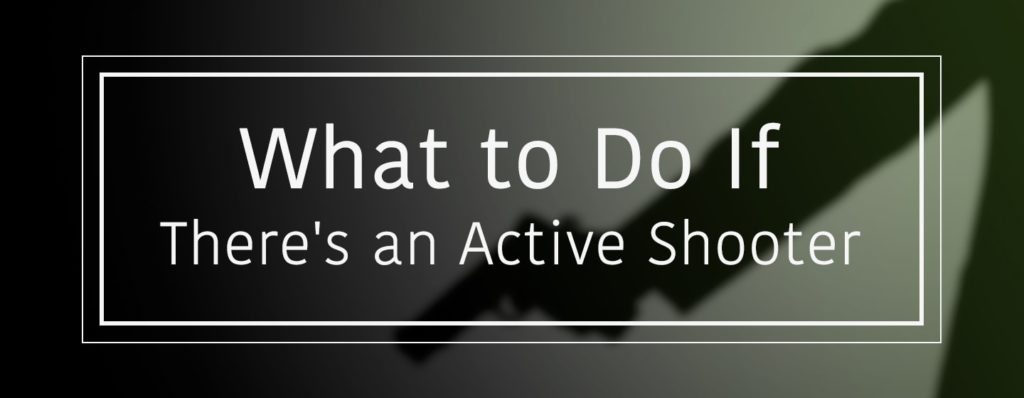
Recently, the FBI reported in a study that active shooter incidents in the United States take place about once a month. But it’s not a stretch to say that it feels like they happen more often. While many western nations around the world do experience active shooter incidents, they happen by far most frequently in the United States.
Occasionally, active shooter incidents will fall into a pattern of once or twice a week, followed by a lull of several weeks, scattered throughout the country, occurring in a variety of different locations: shopping centers, churches, music concerts, fast food outlets, universities, movie theaters, universities and high schools. Unfortunately, there is literally no location in the United States that is free from being a target of an active shooter.
No one ever wants to find themselves in the middle of an active shooter incident, but it’s important to know there are actions you can take to mitigate injuries and fatalities or even prevent them entirely.
Preparation is the most important factor. The days of “It could never happen here” are far behind us, because the reality is that it could happen anywhere, at any time. Regardless of the environment in which you find yourself, there are things you can do to help improve your chances of survival and escape.
LEARN MORE ABOUT OUR SECURITY SERVICES
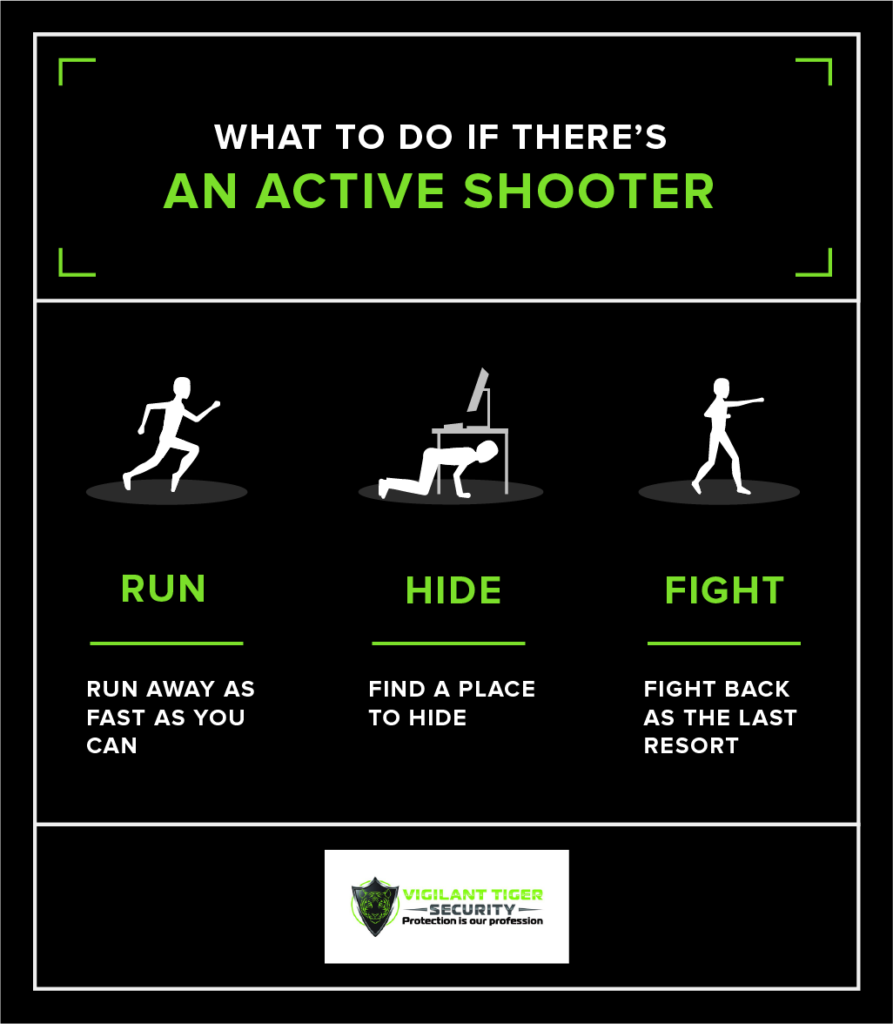
Tips for How to Respond to an Active Shooter Situation
Recognizing that there were enough active shooter situations in the United States that people needed guidance in how to deal with them, the Department of Homeland Security has issued several important pieces of information and pamphlets that provide important instructions on dealing with an active shooter. The main thrust of their advice can be boiled down to three words: run, hide, fight:
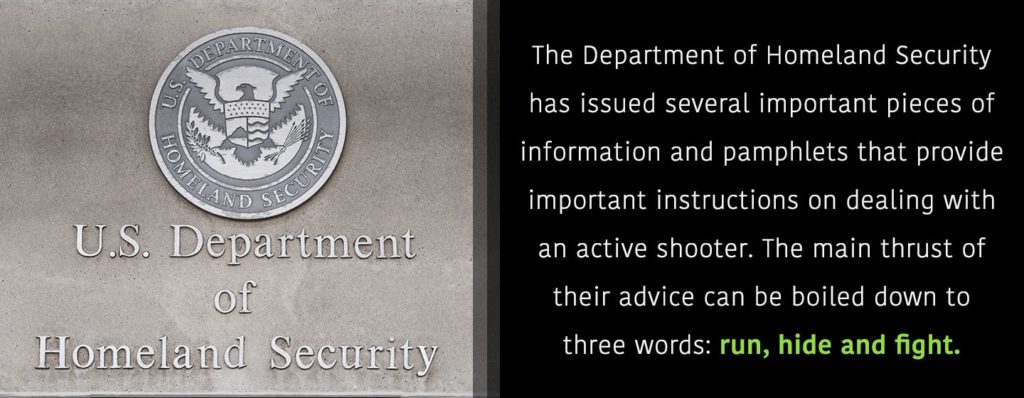
RUN
If you become aware of an active shooter, your best option is to run away as fast as you can:
- If you work in an office, locate all exit doors and be aware of where they lead. If possible, choose the one that leads outside. It’s important to pay attention to the location of exits regardless of where you are.
- Whether you are with your family in a church or in a mall, or with your coworkers in your office, pick a spot outside the active shooting zone where you can all gather when you escape. Please do this ahead of time as part of your regular preparation during evacuation drills.
- If you’re in a movie theater, a church, or some other public facility, make sure you check out all the ways you can exit the theater in an emergency.
- If you’re on a higher floor, never take the elevator. Always take the stairs.
- If you’re on a lower floor, windows are an option. In both the Columbine and the Virginia Tech shootings, students were able to escape via windows.
- If you’re running and the shooter spots you, start to run in a zigzag fashion or from door to door or desk to desk.
- Do not pull a fire alarm. A fire alarm may lead people to believe it’s a fire or drill and proceed to leave in an orderly fashion. You don’t want to confuse them. Yell “gun” or “shooter” as you are running away.
HIDE
If it is impossible to run away from an active shooter, you need to find a place to hide as quickly as possible:
- If you can, find any room that you can lock, be it another office, a closet or a bathroom. Look for rooms near elevators, as they often feature reinforced walls. This offers more protection if the gunman, sensing that someone is hiding in the room, is using a high-powered semiautomatic weapon and tries to fire through the walls.
- Whether you are running or hiding, leave everything behind. The temptation will be to bring important things with you, like your purse or tablet. Ignore the temptation. Things can be replaced if necessary. Humans cannot.
- Once you’re safely in a room, locked the door, turn off the lights and silence your cell phone.
- Stay low in the room but do not lie on the floor. Active shooters tend to shoot higher, so bending down offers an extra element of protection. You also don’t want to lay completely prostrate on the floor because this eliminates the chance of surprising the gunman if either the room is unlocked or he breaks open the door.
FIGHT
If you are unarmed, as most people are when confronted with an active shooter, choosing to fight back is a last resort:
- Find whatever item you can use in your location as a weapon: chairs, paperweights, bookends, stools, scissors. They’re not ideal but they can be useful.
- The best time to fight back is either just as an active shooter enters a room or when they have paused to reload. Recently, a man in Florida was able to prevent further fatalities when he grabbed the gun out of an active shooter’s hands as the shooter paused to reload. Remember — only choose this option as a last resort.
When Help Arrives
At some point, police will arrive and attempt to end the situation:
- In an active shooter incident, it is always better to show rather than to tell.
- Police can never be certain how many shooters are involved in the attack, so when they find you, place your arms in the air and spread your fingers wide to show them you are not armed.
- Resist the temptation to hug the rescuers. This could easily be misinterpreted.
- Do not ask them questions or for first aid unless immediately necessary. They will lead you out of the building and to a safe area. You can then ask questions or request first aid from healthcare responders on the scene.
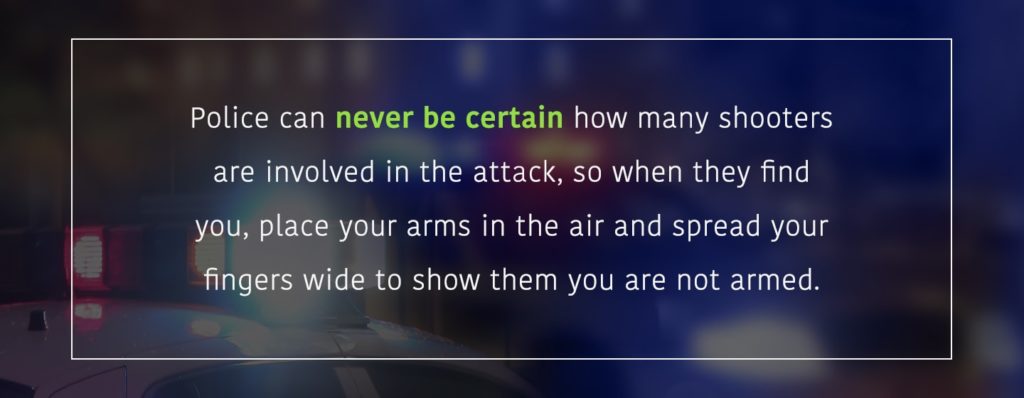
Active Shooter Tips for Specific Locations
1. PUBLIC SCHOOLS
Active shooters have killed many students and teachers at schools like Columbine High School, Sandy Hook Elementary School and Marjorie Stoneham Douglas High School in the past few years. Entire generations of students have grown up in the last two decades aware that this could happen in their school:
- Local authorities and school officials are also aware that any school could be a target to an active shooter. As a result, they have put into place many measures that have stopped many potential active shooter incidents before they could take place.
- Awareness of the signs of a potential active shooter is key. Community members have prevented shootings by reporting disturbing incidents or statements by other individuals about taking guns to school.
- School administrators need to impress on students that it is vitally important that they report any disturbing or unsettling postings by an individual on social media. In almost every school shooting, post-shooting investigations have shown that someone was aware the shooter was thinking about taking guns to school.
- School administrators also need to put an active shooter plan in place and run drills with their students. They need to impress upon them that, if an active shooter is involved, not to pull a fire alarm for the reasons mentioned above.
- School administrators should also make sure local law enforcement has detailed blueprints of the school and are aware of all the possible exits.
- While most American schools screen visitors before they enter the building, school administrators need to stress to parents and students not to let anyone in the door without being screened. Do not hold open the door for either a student or an adult who has not been screened.
2. COLLEGES AND UNIVERSITIES
Colleges and universities require different preparation than public schools. If the shooting takes place at a public school, is likely to happen in one building. At a college or university with multiple buildings, a shooting could take place on one part of the campus while the other part of the campus seems completely normal. Here are the most important points to remember:
- Many of the same rules about awareness in the community apply as much to colleges and universities as they do to public schools. College administrators should create a 24-hour anonymous tip line if they have not done so already.
- Colleges and universities should prepare well in advance with local law enforcement for a potential active shooter crisis. They should also work with their student communities via social media and other popular platforms to both share knowledge on how to deal with an active shooter situation and to alert students if a shooting is taking place.
- Colleges and universities can obtain active shooter pocket cards from the Department of Homeland Security and then distribute them around campus. Digital versions should also be made available on all department websites.
- Colleges and universities should also ban all troublesome individuals from their campuses. Their pictures and information should then be distributed to both campus police and local law enforcement. Once this information is distributed, it’s easier for authorities to prevent a return.
- Again, planning and preparation are key. When your students know how to respond to an active shooter situation or how to spot potential problems, your campus is better protected.
LEARN MORE ABOUT OUR SCHOOL SECURITY SERVICES
3. RELIGIOUS INSTITUTIONS
It’s unfortunate that churches, synagogues and mosques need to think about planning and preparation for active shooter incidents, but as recent events have shown, even religious institutions are not safe from someone with a grudge or desire to do great harm:
- Preparing and planning for a potential active shooter has become a part of every priest’s, minister’s, rabbi’s or imam’s to-do list. Religious authorities must work with local law enforcement. If the religious leader of your community doesn’t have time to do that, your community should select someone who does. This individual can then come back to the larger group and inform them of police plans in case of an emergency.
- Blueprints of the entire facility should be given to the local police along with copies of keys for every door.
- In almost every active shooter incident involving religious communities, the shooting was instigated by a disgruntled member of the community. It’s very important that religious authorities report any suspicious activities or comments from members of their congregation. This is also true for the wider community as well.
- Once a service has started, close the main doors. Assign a responsible member of your congregation to stand in the back and observe those who enter late. They can help guide them to a seat or alert the gathering if there is a potential problem with a troubled individual.
- Religious leaders in the community should make sure their congregations are aware of all exits in the facilities. It may be a good idea to, once or twice a year, hold an active shooter drill with the congregation.
- All of the tips mentioned above in the “run, hide or fight” section also apply in a religious setting.
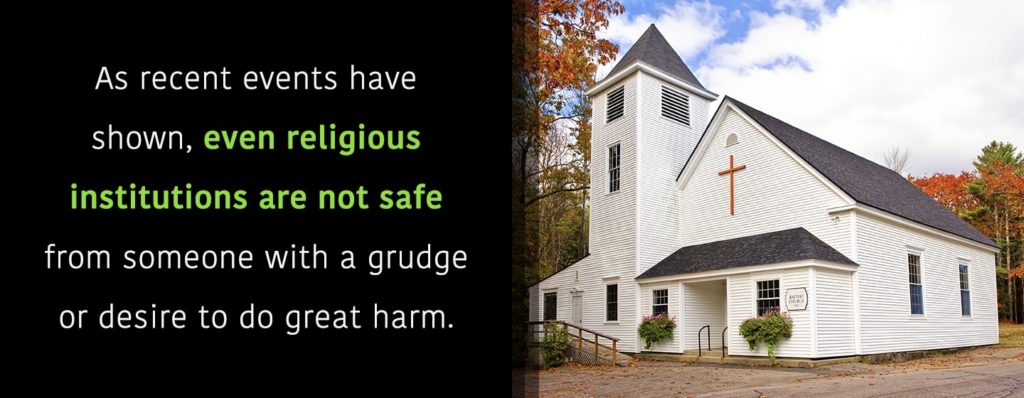
4. BARS, MUSIC VENUES AND MOVIE THEATERS
Each location offers different challenges in determining how to deal with active shooters. In the case of a bar, music venue or movie theater, you are dealing with a new audience each night, so the kind of preparation and drills you can do in the locations mentioned above aren’t possible. But there are still actions you can take to help minimize injuries or even prevent shootings:
- In each of these venues, it is extremely important that your staff is trained in how to deal with an active shooter situation. They need to know how to move people out of a room quickly and with as little panic as possible. They should be familiar with all the exits and know which ones are the best choice for getting people out fastest.
- Experienced bar staff and even music venues and movie theater ushers have probably developed some skills in behavior recognition as part of their regular duties. Local police departments often offer courses in how to spot troubled individuals and how to deal with them until police arrive. Make sure your employees receive this training.
- As noted above, give the police blueprints of the facility so they know where every room is located along with all possible exits. One of the problems the police faced during the Pulse Nightclub shooting in Orlando was that they had no idea of the layout of the inside of the facility, which delayed their entrance into the building.
- Nightclubs and movie theaters should be outfitted with special doors that prevent people from entering from the outside but allow patrons on the inside to exit easily. These doors can be outfitted with alarms that go off when opened in order to prevent customers on the inside from allowing friends to sneak in.
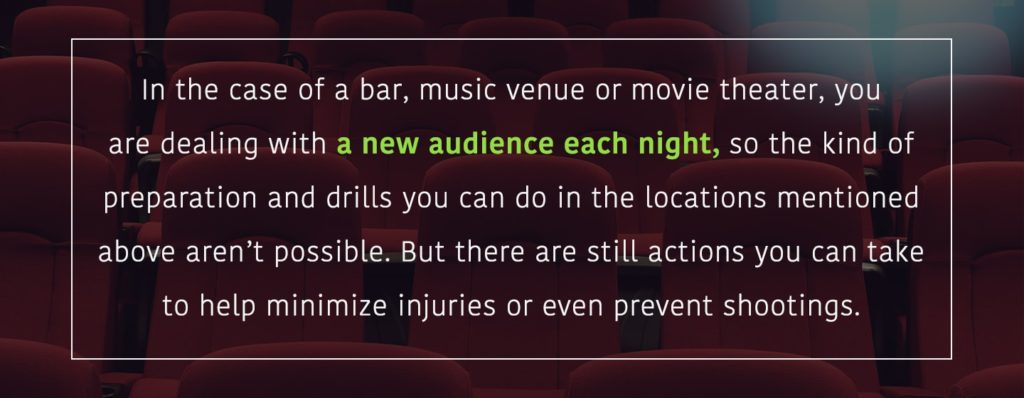
Let Vigilant Tiger Security Help You With Your Security Needs
If you have a facility or an event that needs extra security, it pays to work with a leading company like Vigilant Tiger Security. Veteran-owned and operated, Vigilant Tiger has the experienced and knowledgeable staff to help you improve your security regardless of the situation. From event security to providing the best security for individuals, vigilant Tiger will work with you to make sure your needs are met.
Call us today at 719-313-2950 and let’s talk about your security expectations.
